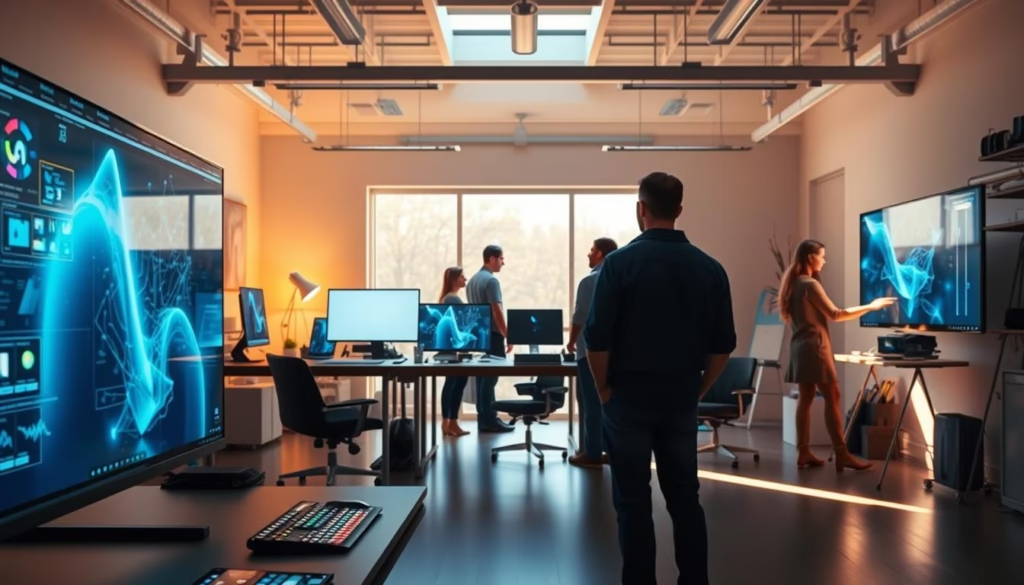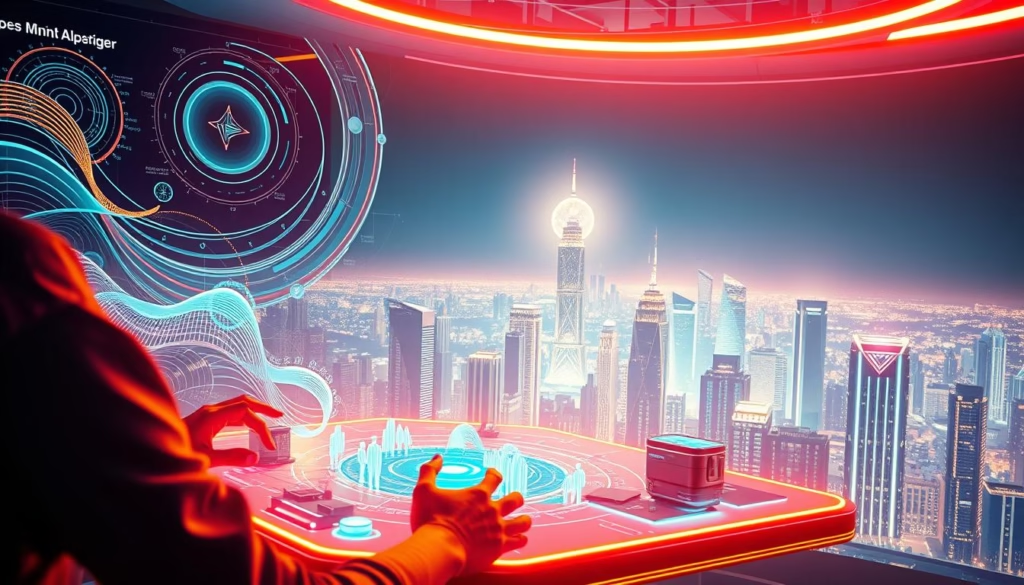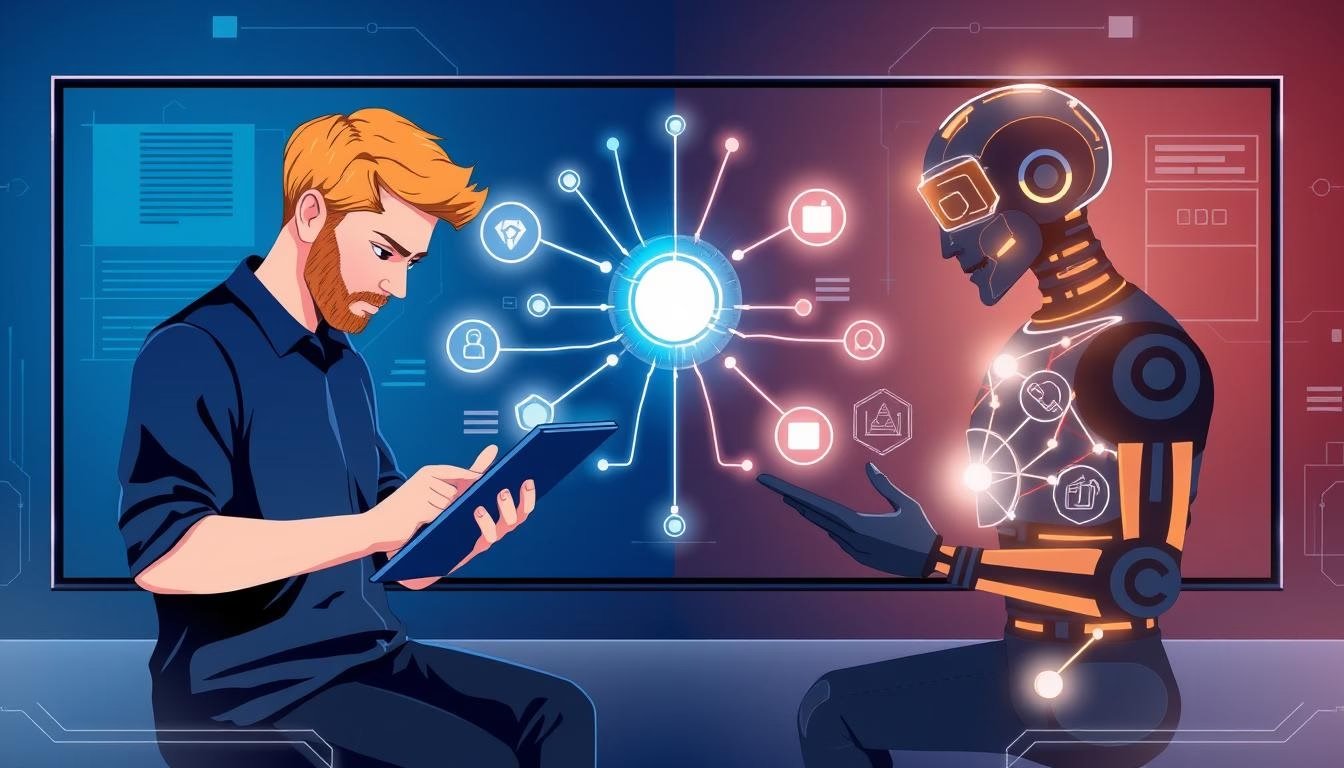“The best way to predict the future is to invent it,” said Alan Kay. He highlighted the need to keep up with new tech. To stay a head is the key to mastering graphic design in the world of Ai .
The graphic design field is evolving rapidly, thanks to the rise of AI tools. These technologies are not only transforming how designers work, but they’re also introducing fresh ideas and creative possibilities.
As we explore this new frontier, it’s essential to understand the role AI plays in graphic design. By learning how to leverage AI effectively, designers can enhance their creativity, improve efficiency, and stay competitive in a fast-changing industry.
Key Takeaways
- Understanding AI-powered graphic design tools is key for designers.
- AI is reshaping graphic design, opening up new creative paths.
- Designers must adapt to these shifts to remain relevant.
- AI tools are making the design process more
- efficient.
- The future of graphic design is deeply connected to AI progress.
The Current State of Graphic Design in the World of AI
The world of graphic design is evolving rapidly with the rise of AI. Understanding how AI is impacting our work—and the changes it introduces—is essential for today’s designers. In particular, graphic design automation and machine learning are playing major roles, fundamentally reshaping how we approach and solve design problems.
From Traditional to Digital: The Design Evolution
Over the past few years, the shift from traditional to digital graphic design has happened rapidly. Instead of relying on manual methods, designers now use powerful software tools. This transformation has not only changed our workflow but also unlocked new avenues for creativity. As noted by a design expert,
“The digital revolution has empowered designers to experiment and innovate like never before.”
How AI is Transforming the Designer’s Workflow
AI is changing how we work by automating routine tasks, boosting creativity, and introducing new design tools.
These tools can even pick colors and fonts, letting us focus on bigger creative decisions.
Additionally, they allow designers to generate multiple design variations quickly, enhancing creative flexibility.
Moreover, by using Ai in graphic design, we can achieve more efficiency and innovation. This improves our work and the value we give to clients.
Getting Started with AI-Powered Graphic Design Tools
AI-powered graphic design tools are changing the game. We’re here to guide you through the process of getting started. Understanding the tools that are revolutionizing our industry is key. AI for creative design is not just a trend; it’s a new standard that’s making our work better and easier.
Selecting the Right AI Design Tools for Your Needs
Choosing the right AI design tool can be tough. Think about what you need and look for tools that fit those needs. Some popular options include:
- Adobe Creative Cloud’s AI features
- Canva’s AI Design Assistant
- Specialized AI design platforms like DALL-E and Midjourney
Setting Up Your First AI Design Workspace
After picking your AI design tool, setting up your workspace is next. Get to know the tool’s interface and what it can do. Digital design with AI needs creativity and technical skills. Setting up your workspace right is key to being productive.
Understanding AI Design Terminology
As we explore AI-powered graphic design, knowing the terms is important. Terms like “machine learning,” “neural networks,” and “deep learning” are common in design talks. Learning these concepts will help you understand enhancing graphic design through AI better.
Essential AI Tools Every Modern Graphic Designer Should Master
In today’s fast-paced design world, learning AI tools is a must. Graphic designers look for ways to boost creativity and make work easier. Moreover, AI tools are changing the game, helping us create top-notch designs quickly.
Adobe Creative Cloud’s AI Features
For instance, Adobe Creative Cloud has added AI to many apps, making design better. Adobe Sensei and AI in Photoshop and Illustrator are key parts of this.
Mastering Adobe Sensei
Adobe Sensei is the brain behind Adobe’s AI. It automates tasks, analyzes data, and offers smart insights. Learning Adobe Sensei can really improve our design skills.
AI-Powered Photoshop and Illustrator Features
Photoshop and Illustrator now have AI features that make hard tasks easier. For example, Photoshop’s “Content-Aware Fill” and Illustrator’s “Image Trace” use AI to speed up work. This lets us focus more on the creative side of design.
Canva’s AI Design Assistant Capabilities
Canva, a favorite design platform, has added AI too. Its AI design assistant helps with image resizing, color and font suggestions. These tools help designers make professional designs fast.
Specialized AI Design Platforms Worth Exploring
Beyond the popular tools, there are other exciting AI design platforms worth exploring, such as Prisma and Deep Dream Generator. For example, Prisma transforms regular images into artistic styles, while Deep Dream Generator produces surreal, dream-like visuals. These tools not only add a creative twist but are also enjoyable and practical to use.
By learning to use these platforms effectively, designers can enhance their creativity, improve their design quality, and stay competitive in the ever-evolving world of graphic design.
Creating Stunning Imagery with AI Generation Tools
Designers can now make stunning images with ease thanks to AI tools. These tools use artificial intelligence to create visuals that were once impossible. By adding AI to their work, designers can make their creative process better and come up with new ideas.

Step-by-Step Guide to Using DALL-E for Design Elements
DALL-E is a strong AI tool that makes realistic images from text prompts. To begin, write a detailed text about the image you want.DALL-E will then show you many image options.
You can use DALL-E to make special design parts like icons, patterns, or scenes.
Mastering Midjourney for Commercial Design Projects
Midjourney is a popular AI tool for designers. To get good at Midjourney for work, learn its commands and settings. Try different prompts and settings to get what you need.
Midjourney can make many kinds of visuals, from abstract art to real product pictures. It’s great for work design projects.
Techniques for Refining AI-Generated Images
AI tools can make great images, but they might need some touch-ups. To improve AI images, you can change colors, adjust the layout, and add textures. Mixing AI images with traditional design can make your work stand out.
Streamlining Your Workflow: Automating Design Tasks with AI
AI in graphic design has changed the game. It lets us automate boring tasks. With AI tools for graphic designers, we can spend less time on routine work. This means we have more time for the creative stuff.
Identifying Tasks Suitable for AI Automation
First, we need to figure out which tasks AI can handle. We look at our workflow and find tasks that take too long. Using machine learning in graphic design, we can make these tasks faster. This way, we have more time for the fun stuff.
Creating Efficient Automated Design Workflows
After picking the tasks to automate, we set up our workflows. We choose the best AI-powered design tools and make sure they work well together. This makes our work faster and less prone to mistakes.
Generating Multiple Design Variations with AI
AI is amazing for making lots of design options fast. With AI generation tools, we can try out many ideas. This lets us pick the best design for our project.
As we keep using graphic design automation, we’ll find even more ways to improve our work. We’ll make better designs faster.
“AI is not just a tool, it’s a collaborator that can help us unlock new creative possibilities.” –
Enhancing Your Creative Process Through AI Collaboration
AI in graphic design is more than just automation. It’s about making our creative work better together. Using AI tools, we can make our creative process more efficient and innovative.

Using AI as a Brainstorming Partner
AI can be a great brainstorming partner. It helps us come up with new ideas and explore different design paths. This teamwork can lead to more creative solutions.
Prompt Engineering for Better Results
Good prompt engineering is key when working with AI. By creating well-designed prompts, we can get more relevant and useful results from AI.
Iterating with AI Suggestions
Working with AI suggestions helps us improve our designs. This process can introduce us to new design elements and approaches we might not have thought of.
Breaking Creative Blocks with AI-Generated Inspiration
AI can be a powerful tool to overcome creative blocks. It analyzes our design preferences and style to generate new ideas. This helps us break through barriers and keep creating.
Using AI for creative inspiration has many benefits:
- Access to a vast library of design elements and styles
- The ability to generate multiple design variations quickly
- Inspiration for new and innovative design approaches
By working with AI as a partner in graphic design, we can enhance our creative abilities. This leads to more engaging and innovative designs.
Developing a Distinctive Design Style in an AI-Dominated Landscape
Graphic design is changing fast with AI’s help. To stand out, we must create unique styles. AI can make great designs, but we need to add our human touch.
Techniques for Maintaining Human Touch in AI-Assisted Work
To keep our designs human, we focus on what AI can’t do. This includes:
- Adding personal experiences and emotions to our work
- Seeing AI as a tool, not a replacement for our creativity
- Emphasizing the small details that make designs feel human, like imperfections
This way, our designs will not only look good but also touch people’s hearts.
Building Signature Elements That Differentiate Your Work
Creating unique elements is key to a recognizable style. We can do this by:
- Using a consistent color palette or typography
- Adding special visual elements or motifs
- Trying out different techniques and mediums
This helps us build a style that shines, even with AI around.
The secret to success is not to fight AI but to use our human side. This way, we make designs that are not just pretty but also meaningful and powerful.
Leveraging AI for Advanced Color Theory and Typography
Graphic designers are always looking to improve their work. AI tools are changing how we handle color and typography. They help us make designs that really grab people’s attention.
Generating Perfect Color Palettes with AI Tools
AI can create color schemes that are hard to come up with on our own. These tools look at lots of data to find colors that work well together. They help us make designs that people love.
For example, AI tools can look at a brand’s colors and suggest new ones. This makes our designs look better and keeps them consistent everywhere.
AI-Powered Font Pairing and Typography Enhancement
Typography is key in graphic design, and AI helps a lot. For example, AI looks at fonts and suggests pairs that look good and work well together.
Moreover, AI can also tweak font designs to make them easier to read. It adjusts things like spacing and kerning to improve how text looks and flows.
Creating Accessible Designs with AI Assistance
AI is a powerful tool for creating designs that are inclusive and accessible to everyone. For instance, it checks important elements like color contrast and font sizes to ensure designs can be easily understood and used by people with visual impairments. As a result, more individuals can enjoy and engage with our work.
Overall, the application of AI in our design process not only enhances efficiency but also ensures that our creations are both visually appealing and accessible to all.
Navigating Ethical Considerations in AI-Assisted Graphic Design
As we use more AI tools in graphic design, we must think about the ethics. Through AI in design is not just about its power. It’s also about the impact of our choices.
Understanding Copyright and Ownership in AI-Generated Content
Copyright and ownership are significant concerns with AI-generated content. AI designs often raise the question: who owns the final product—the designer or the AI? Therefore, we need to consider both the legal and ethical aspects of using AI-generated material, especially in business projects.
To navigate these challenges effectively, designers should understand the terms of use for AI tools and how copyright laws apply to AI-created works.
Best Practices for Transparency with Clients
To begin with, being open is essential when working with clients on AI projects. Designers should tell clients about AI tools and their role in design. In other words, this means explaining how AI content is used and the pros and cons of AI-assisted design.
Ultimately, being clear helps designers gain trust with clients. It also ensures they follow ethical standards
Future-Proofing Your Design Career in the Age of AI
As a result, AI is changing graphic design, and designers need to adapt. The rise of AI-powered graphic design tools is reshaping design work. This transformation brings both opportunities and challenges.
To keep up, designers must blend technical and creative skills with AI. Moreover, they should learn how to use machine learning in graphic design to boost their work.
Essential Skills to Develop Alongside AI Proficiency
Important skills include:
- Understanding AI design tools and their uses
- Developing creative vision and strategic thinking
- Improving communication and teamwork skills
- Keeping up with new design trends and tech
Marketing Yourself as an AI-Enhanced Designer
To stand out, designers should show their AI skills. This means:
- Sharing projects that mix graphic design automation with human touch
- Highlighting AI’s benefits, like better efficiency and new ideas
- Building a strong personal brand that shows your AI and creativity skills
Conclusion: Embracing the Future of Human-AI Design Collaboration
Graphic design is changing fast with AI’s help. AI is making our work more efficient and creative. It lets us do more and better work.
Furthermore, We’ve seen new tools like Adobe Creative Cloud and Canva. They use AI to help us design faster. Tools like DALL-E and Midjourney also help us create new ideas.
In addition, Using AI in design is more than just new tools. It’s about changing how we design. By working with AI, we can do more creative things. This will shape the future of design.
FAQ
What is AI-powered graphic design?
AI-powered graphic design uses artificial intelligence to help with design tasks. This includes making visual elements, picking colors, and suggesting fonts.
How do AI design tools work?
AI design tools use machine learning to analyze data and make decisions. They learn from a lot of design data. This helps them create great designs and offer insights to designers.
What are the benefits of using AI in graphic design?
Using AI in graphic design makes things more efficient and creative. It automates tasks, suggests designs, and helps explore new ideas. This leads to more innovative and effective designs.
Can AI replace human graphic designers?
AI has improved a lot in graphic design, but it can’t replace human designers. AI is great for supporting human creativity. Humans add nuance, empathy, and understanding that AI can’t match.
What are some popular AI-powered graphic design tools?
Popular AI tools include Adobe Creative Cloud’s AI features, Canva’s AI assistant, DALL-E, and Midjourney. They help with design elements, suggestions, and automating tasks.
How can I get started with AI-powered graphic design?
Start by exploring AI design tools and learning about their features. Take online courses or workshops to learn more. This will help you integrate AI into your work.
What are some best practices for using AI in graphic design?
Understand AI’s limits and be open with clients about using it. Use AI to enhance human creativity, not replace it. Stay updated with AI trends to get the most out of it.
How can AI enhance my design workflow?
AI can automate tasks, suggest designs, and spark new ideas. Using AI tools can make your workflow smoother. This lets you focus on the creative parts of your job.
What are the potentially drawbacks of relying on AI in graphic design?
Relying too much on AI might lead to similar designs and biases. Be aware of these risks. Use AI to support human creativity and judgment.




One thought on “Mastering Graphic Design in the World of AI”